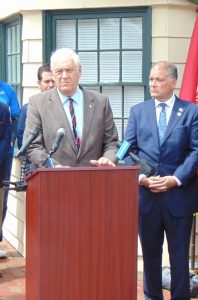By Donna Deedy
People are calling for reform after the recent onslaught of mass shootings that included an elementary school massacre in Uvalde, Texas, where 19 young children and two teachers were gunned down in their classroom with an automatic assault rifle.
“We’re seeing an absolute epidemic and the loss and slaughter of innocence and it has to stop,” said New York State Assemblyman Steven Englebright (D-Setauket). Corporate greed, he said, has mixed into a movement that has become very confused. “People are identifying with weapons.”
Englebright pointed out Gov. Kathy Hochul’s (D) response to the latest school tragedy. According to a June 6 press release, she “signed a landmark legislative package to immediately strengthen the state’s gun laws, close critical loopholes exposed by shooters in Buffalo and Uvalde and protect New Yorkers from the scourge of gun violence.”
What exactly can a person do to reverse the gun violence epidemic that is plaguing the nation?
The nonprofit group Sandy Hook Promise has outlined a comprehensive response to that very question. Founded by some of the parents whose first graders were murdered in their Sandy Hook Elementary School in Newtown, Connecticut, in 2012, the group has taken a holistic approach to the situation and they say they are leading out of love. Their programs combine community awareness and mental health research with effective prevention strategies, while separately advocating for sensible, bipartisan gun safety policies.
“Take your heartache, your fear, your anger and sadness, and channel them into action,” said Nicole Hockley and Mark Barden, co-founders and CEOs of Sandy Hook Promise, who each lost a son in the Newtown tragedy. “We must take action today and every day until this epidemic of violence ends.”
So far, more than 14 million people and 23,000 schools nationwide have participated in Sandy Hook Promise programs, according to their website, which has led to 115,000 anonymous tips and reportedly resulted in 321 confirmed lives saved with crisis interventions.
Here in Suffolk County, Sheriff Errol Toulon Jr. (D) launched Sandy Hook Promise’s Know the Signs initiative in 2018, his first year in office.
“After the shooting in Parkland, Florida, I made school safety a priority for the Sheriff’s Office,” Toulon said.
Over the last few years, county officers have trained more than 30,000 students, teachers and staff with Sandy Hook’s methods. Miller Place, East Islip, Central Islip, Lindenhurst and Bridgehampton are a few school districts that have participated in the program.
Toulon said he’s proud to have partnered with the Sandy Hook foundation and encourages more people to participate in its lifesaving movement.
“Now, more than ever, programs like Sandy Hook Promise are needed as school threats are on the rise,” he said.
TBR News Media reached out to few school districts in our circulation area for comments on their programs. Through their public relations firm, Smithtown Central School District preferred not participate in the story but it posts position papers on mental health and social and emotional learning on the district’s website. Three Village said it is not affiliated with Sandy Hook Promise. We did not receive a response to follow-up questions about their programs before press deadlines.
Sandy Hook Promise encourages anyone interested in pursuing community support for its programs to become a “promise leader” by registering on its website.
Here’s a brief overview of Sandy Hook Promise programs:
There are four distinct programs developed by educators with expertise in curriculum development. All of it is accessible in person or online via Sandy Hook Promise’s Learning Center at no cost. Their award-winning programs include lesson plans, activities, games and discussion guides. Anyone who registers on the group’s website, www.sandyhookpromise.org, can access the charity’s free digital library that includes training sessions. The Start with Hello and Say Something programs both fall under the umbrella of the organization’s Know the Signs program.
Start with Hello
Start with Hello teaches children and youth how to minimize social isolation and empathize with others to create a more socially inclusive and connected culture. That lesson is explained in three steps: 1. See someone alone; 2. Reach out and help; 3. Start with Hello.
Say Something
Experts say that people who are at risk of hurting themselves or others often show warning signs before they carry out an act of violence. Sandy Hook Promises trains middle school and high school students to spot these signs and do something about it. This program also follows a three-step approach: 1. Recognize the signs of someone at risk, especially on social media; 2. Act immediately and take it seriously; 3. Learn how to intervene by telling a trusted adult or by using the program’s anonymous reporting system.
Say Something Anonymous Reporting System
The Say Something Anonymous Reporting System can be used when students see classmates who are at risk of harming themselves or others. It requires additional training for school district personnel and local law enforcement. It is reportedly the only anonymous reporting system in the U.S. that offers training along with a mobile app, a website and a hotline — exclusively for schools.
The charity also runs its National Crisis Center that operates 24/7, 365 days a year. Experienced crisis counselors trained in suicide prevention, crisis management and mental health support respond to the tips.
So far more than 120 school districts participate in this program, along with the states of Pennsylvania and North Carolina. A webform is available for schools and agencies interested in registering for access to this system.
SAVE Promise Club
Students interested in starting a club or leading a committee within an existing club receive, at no cost, tools from Sandy Hook Promise, so they can plan activities that promote kindness and inclusiveness to instill the value of looking out for one another in their community. The club, called Students Against Violence Everywhere, is supported by a contract with U.S. Department of Education’s Office of Safe & Supportive Schools and can be accessed from the government’s website: safesupportivelearning.ed.gov/resources. The initiative reinforces the key messages of the Start with Hello and Say Something programs.
Gun safety policies
The mission of Sandy Hook Promise is to end school shootings and create a culture change that prevents violence and other harmful acts that hurt children. It advocates what it calls sensible, bipartisan gun safety policies to support that goal. They’ve created a sister organization, called an action fund, that works to pass legislation that advances school safety, mental health and gun violence prevention issues.
“We believe in protecting the second amendment,” said Aimee Thunberg, Sandy Hook Promise’s media contact. “But we support policies that promote safe gun ownership to keep our children and communities safe.”
The group supports the bipartisan background check legislation that recently passed in the House of Representatives, but still needs Senate attention. The organization also supports extreme risk protection orders, or red-flag laws, that allows family and law enforcement to seek the court’s help to temporarily separate people in crisis from firearms. New York State’s red-flag law was implemented in August 2019 with roughly 160 weapons seized in Suffolk County, more than any other county in the state. The organization also advocates bans on assault-style weapons and limits on high-capacity magazines to prevent more mass shootings.
Anyone who wants to, can get involved to help the Sandy Hook mission. In addition to programs for parents, students, teachers and other youth organizations, Sandy Hook Promise welcomes volunteers to help showcase their programs at community events to build better awareness.
Otherwise, in response to the Robb Elementary School shooting in Uvalde, Texas, Sandy Hook Promise has compiled a list of very specific things people can do to help end gun violence. It’s available at www.sandyhookpromise.org/blog/gun-violence/what-you-can-do-right-now-to-help-end-gun-violence.
“Our key message is that gun violence is preventable, and we have actions that every individual can take in their family, community, schools and with politicians,” said Nicole Hockley in a recent blog post. “Don’t back away. Be part of the solution.”
TBR News Media asks readers who have participated in Sandy Hook Promise programs to email us at [email protected] and let us know about your experience.







































